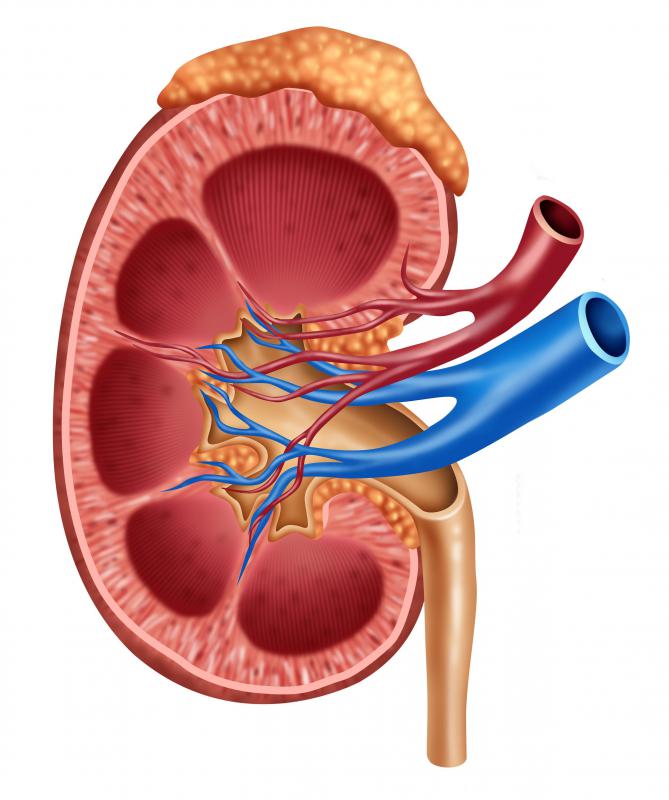At WiseGEEK, we're committed to delivering accurate, trustworthy information. Our expert-authored content is rigorously fact-checked and sourced from credible authorities. Discover how we uphold the highest standards in providing you with reliable knowledge.
What is an Adrenalectomy?
An adrenalectomy is a surgical procedure in which one or both of a patient’s adrenal glands are removed via open or laparoscopic methods. The adrenal glands, also called suprarenal glands, are hormone excreting glands located just above the kidneys in the back of the abdomen. Doctors usually recommend an adrenalectomy if the patient has either benign or malignant tumors on an adrenal gland. A malignant tumor is a cancerous tumor that becomes progressively worse and can spread to other tissues. A benign tumor does not grow or spread aggressively, but may cause other health problems and may, in some cases, eventually become malignant.
The adrenal glands regulate the release of hormones, such as cortisol and adrenaline, or epinephrine. Hormones are chemical messengers that are sent out by endocrine glands, such as the adrenal gland, to illicit a response from particular cells in the body. The adrenal glands are principally involved in controlling the stress response in the body. A tumor, benign or malignant, can cause too much of these hormones to be released, possibly creating adverse effects in the body. Some of these effects include Cushing’s Syndrome, and pheocromocytoma, depending on the hormone that is being secreted in excess.

If the adrenal glands have a cancerous tumor, a tumor that causes excess hormone secretion, or if the gland’s activities are exacerbating another condition, such as breast cancer, a doctor may recommend an adrenalectomy. This can be performed either laparoscopically or as an open surgery, depending on the patient’s needs. The patient may be put on medications prior to surgery to control symptoms such as high blood pressure or low potassium levels. On the day of the surgery, an anesthesiologist will administer general anesthesia to the patient through an IV, a needle that injects the medication directly into the bloodstream, so that the patient is unconscious throughout surgery.

If the patient has an open adrenalectomy, the surgeon will make an incision in one of four locations, depending on each case’s needs. In the anterior approach, a surgeon will make a horizontal cut into the belly just under the ribcage. The incision may be limited to just the right or left side if only one adrenal gland is being removed. If both glands are affected, the incision may stretch horizontally across the entire belly or extend vertically down the abdomen. A surgeon may reach the adrenal glands more directly through the posterior approach, making one or two incisions, depending on whether one or two glands need to be removed, into the back below the ribcage.

A physician may choose to access the adrenal gland through the flank approach, especially in cases where the patient is very obese. In this procedure, the patient lies on one side while the surgeon makes an incision in the other side. If two glands need to be removed, the surgeon must operate on and stitch one side, then flip the patient over and repeat the procedure on the other side. The chest approach to an open adrenalectmy is typically used when the tumor is very large or the doctor suspects that other organs are affected. In this approach, the doctor will cut into the chest cavity to access and remove the adrenal gland.

Laparoscopic procedures are less invasive, or require smaller incisions, than an open adrenalectomy. In these operations, a surgeon will make four tiny incisions in the patients side, through which surgical tools and the laparoscope are inserted. A laparoscope is an imaging device that allows a doctor to visualize the internal organs without opening up the body using a larger incision. While a laparoscopic adrenalectomy may have less risks of complications than an open surgery, it is not ideal for all patients. Tumors over four inches (roughly 10cm) or malignant tumors require a more aggressive surgery, and are better dealt with through open adrenalectomy.
AS FEATURED ON:
AS FEATURED ON:














Discuss this Article
Post your comments